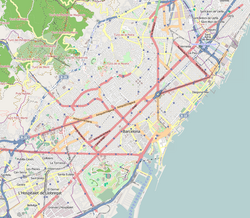Passeig de Gràcia station
This article relies largely or entirely on a single source. (March 2017) |
Passeig de Gràcia station (Catalan pronunciation: [pəˈsɛdʒ də ˈgɾasiə]) is an underground railway and metro station in Barcelona located under Passeig de Gràcia, in Eixample district. It is one of the Barcelona's busiest railway stations and important stop for Barcelona Metro network. It is served by Rodalies de Catalunya suburban railway lines R2 and regional lines R11, R13, R14, R15 and R16, and it is also served by TMB-operated Barcelona Metro lines L2, L3 and L4.
The station includes an artwork entitled Ballarins nus by Angel Orensanz.[3]
History[edit]
The first railway station that existed in Passeig de Gràcia was built in 1902. The original station was not underground and lines were linked directly with the lines to Girona and Tarragona. In 1950s it was decided to build a new underground station and cover all the tracks along Aragó street. The work started in 1954 and the station was finished in 1959 as part of the Aragó Tunnel. It is planned to reform the railway station completely to make it more accessible and to improve its aspect.
Services[edit]
Rodalies de Catalunya[edit]

Rodalies de Catalunya railway station is situated under Aragó street and between Passeig de Gràcia and Roger de Llúria street. The station has four accesses from the street and all of them go to the main hall where it is possible to connect directly with Barcelona Metro line 3. The main hall has some ticket offices, ticket vending machines and a kiosk. The trains run on the lower level where there are two platforms, each one equipped with a café-bar.
Barcelona Metro[edit]
- Barcelona Metro line 2 station was opened in 1995, with the opening of the line between Sant Antoni and Sagrada Família. It is located under Gran Via de les Corts Catalanes and near Passeig de Gràcia. Line 2 station has two accesses each one equipped with many ticket vending machines. On the lower there are two platforms, each one separated from the other like London Underground tube stations. It is directly connected to Barcelona Metro line 4 station and to Barcelona Metro line 3 and Rodalies de Catalunya railway station through a long corridor.

- Barcelona Metro line 3 station was opened in 1924 with the opening of the line between Catalunya and Lesseps, the first metropolitan railway in the city. The station is located under Passeig de Gràcia between Consell de Cent and Aragó streets and has two halls, one at each side of the station. It is directly connected to the railway station and to line 2 and line 4 through a 250 metres-long corridor.
- Barcelona Metro line 4 station was opened in 1973 with the opening of the line between Urquinaona and Joanic. The station is located under Passeig de Gràcia, between Gran Via and Diputació street and has an only hall situated in the south part of the station. The hall has a head office and some ticket vending machines. It is connected to line 3 station through the long corridor. On the lower level there are two platforms, each one separated from the other and connected to line 2 station.
References[edit]
- ^ "Adif - Información de estaciones - Barcelona Passeig de Gràcia". ADIF. Retrieved 3 September 2019.
- ^ "Atocha Cercanías lidera las estaciones de tren en España con más de 270.000 viajeros al día". Tribuna de Salamanca (in Spanish). 3 April 2019. Retrieved 2 September 2019.
- ^ "Bailarines desnudos, "Passeig de Gràcia" subway station, Barcelona, Spain". www.angelorensanz.com. Retrieved 2015-01-12.
External links[edit]
 Media related to Barcelona Passeig de Gràcia train station at Wikimedia Commons
Media related to Barcelona Passeig de Gràcia train station at Wikimedia Commons- Rodalies de Catalunya
- Information about L2 metro station at TMB
- Information about L3 metro station at TMB
- Information about L4 metro station at TMB
- Transports Metropolitans de Barcelona
- Information about Rodalies railway station at Trenscat.com
- Information about L2 metro station at Trenscat.com
- Information about L3 metro station at Trenscat.com
- Information about L4 metro station at Trenscat.com






